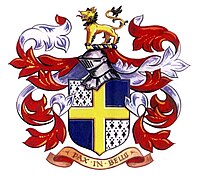Francis Osborne, 5th Duke of Leeds
George III | |
|---|---|
| Prime Minister | The Right Hon. William Pitt |
| Preceded by | The Earl Temple |
| Succeeded by | The Lord Grenville |
| Leader of the House of Lords | |
| In office 1789–1790 | |
| Preceded by | The Lord Sydney |
| Succeeded by | The Lord Grenville |
| Personal details | |
| Born | 29 January 1751 |
| Died | 31 January 1799 (aged 48) Tory |
| Spouses | |
| Children |
|
| Parent(s) | Thomas Osborne, 4th Duke of Leeds Lady Mary Godolphin |
| Alma mater | Christ Church, Oxford |
Francis Godolphin Osborne, 5th Duke of Leeds,
Background and education
Carmarthen was the only surviving son of Thomas Osborne, 4th Duke of Leeds, by his wife, Lady Mary, daughter of Francis Godolphin, 2nd Earl of Godolphin, and Henrietta Godolphin, 2nd Duchess of Marlborough. He was educated at Westminster School and at Christ Church, Oxford.[1]
Political career
Carmarthen was a
Early in 1783, Carmarthen was selected as ambassador to France, but he did not take up this appointment, becoming instead
Leeds had done nothing to foster good relations with the newly independent United States: two future Presidents, John Adams and Thomas Jefferson, as envoys from the United States, both complained of his obstructive attitude and "aversion to having anything to do with us".[4] While Adams, who was rather Anglophile by inclination, was prepared to forgive and forget, Jefferson was not, and it can be argued that Leeds's only lasting achievement was to foster Jefferson's implacable hostility as President to Great Britain and its rulers.[5]
Subsequently, Leeds took little part in politics: in 1792, hearing rumours that a new coalition might be formed, he unwisely offered himself as its head and met with a firm rebuff from both Pitt and the King.[6]
Family

Leeds married firstly in 1773 Lady Amelia Darcy, daughter of Robert Darcy, 4th Earl of Holderness on 29 November 1773. Lady Amelia became Baroness Darcy de Knayth and Baroness Conyers in her own right in 1778. They were divorced in 1779.[7] Their marriage produced three children:
- George William Frederick Osborne, Marquess of Carmarthen (21 July 1775 – 10 July 1838), later 6th Duke of Leeds; married Lady Charlotte Townshend, daughter of the 1st Marquess Townshend, on 17 August 1797 and had issue.
- Lady Mary Henrietta Juliana Osborne (7 September 1776 – 21 October 1862); married Thomas Pelham, 2nd Earl of Chichester (28 April 1756 – 4 July 1826) in 1801 and had issue.
- Lord Francis Osborne (18 October 1777 – 15 February 1850), later 1st Baron Godolphin; married The Hon. Elizabeth Eden, third daughter of the 1st Baron Auckland, on 31 March 1800 and had issue.
He married secondly Catherine, daughter of Thomas Anguish, in 1788 and had two more children:
- Lord Sidney Godolphin Osborne (1789–1861); unmarried.
- Lady Catherine Anne Sarah Osborne (1791–1878); married Major John Whyte-Melville on 1 June 1819 and had issue.
Leeds died in London in January 1799, aged 48, and was buried in the Osborne family chapel at
References
- ^ a b c d Chisholm 1911.
- ^ Jeremy Black, British Foreign Policy in an Age of Revolutions, 1783-1793 (1994), pp. 55-56.
- ^ William Hague William Pitt the Younger.[page needed]
- ^ McCullough, David John Adams, Simon and Schuster New York (2001).[page needed]
- ^ McCullough, John Adams.[page needed]
- ^ Hague, William William Pitt the Younger Harper Collins (2004).[page needed]
- ^ "House of Lords Journal Volume 35: April 1779 11-20". British History Online. HMSO. Retrieved 13 September 2021.
- This article incorporates text from a publication now in the public domain: Chisholm, Hugh, ed. (1911). "Leeds, Thomas Osborne, 1st Duke of s.v. Francis Osborne, 5th duke of Leeds". Encyclopædia Britannica. Vol. 16 (11th ed.). Cambridge University Press. p. 368.

